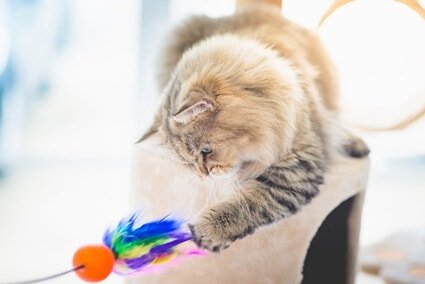To call cats lazy would be a misinterpretation of their behavior. Cats do need plenty of sleep, but they also require regular exercise and mental stimulation. If you spend all day at work, which is the case for most people, it can be difficult to provide this stimulation level to your feline.
Cats are happiest when expressing natural behaviors, such as chewing, scratching, climbing, and hunting. Create a home environment that encourages this behavior, such as intelligence puzzles, a cat condo, or adding a second cat.
No matter how much you cat-proof your home, it can be a dangerous place, especially if your pet is left unsupervised. Use these tips to ensure that your cat is safe and contented when you’re away from home.
Environmental Enrichment for Cats
It’s good that you are trying to provide an enriching environment for your cat. Research shows that boredom is bad for the health of cats. Cats that live in an enriched environment have increased levels of brain activity. Regular stimulation will benefit cats in the following ways:
- Better sleep – Cats that are stimulated throughout the day enjoy more restorative sleep.
- Improved mood – Physical activity releases endorphins and may help to protect against feline depression and anxiety.
- Protects against brain decline in old age – Old cats may experience brain cell death (similar to the neurogenerative diseases seen in humans). Brain stimulation helps to build synapses (the connections between neurons) which may protect against brain decline in old age.
- Good for bone & joint health – Regular physical activity helps to protect against bone conditions and feline joint disorders.
- Weight management – Cats that play regularly are less prone to obesity and diabetes.
- Improves behavior – If cats live in stimulating environments, they can express their natural tendencies. This includes hunting, scratching, and chewing. This improves their behavior inside the home.

How Much Exercise and Stimulation Do Cats Need?
There is no real consensus on this issue. However, most specialists would agree that indoor cats rarely get enough physical exercise.
One study found that domestic cats allowed to roam free traveled a radius of 4.9 acres from their home. This suggests domestic cats walk reasonably long distances, given the opportunity.
Owners should aim to play with their cats for 3 x 15 minutes per day, as long as they are fit and healthy. They also advise owners to provide an “enriching environment” for their cats.
Intelligence Toys & Food Puzzles
“Intelligence toys” or “food puzzles” are becoming increasingly popular. These toys are ideal for entertaining cats because they stimulate the five senses and mimic a cat’s natural hunting tendencies. Not only that, they encourage cats to become more dexterous and spatially aware.
So, how do intelligence toys work? Well, the owner places the cat’s favorite treat somewhere on the puzzle board. To retrieve the treat, the cat must lift lids, open drawers, push the treat through a tunnel, or even use its tongue to retrieve it from a narrow hole.
The reward at the end is highly satisfying, so cats quickly become accustomed to this game. As a result, cats will quite happily seek out and play these puzzles without being prompted.
So, try placing one of these toys in the house a couple of days per week. Don’t make them available every day as boredom might set in.
Get Another Cat
Cats are not pack animals, but they are friendlier with each other than we realize. According to CATS, feral cats with all their needs met (food, shelter) form communities with other cats. Fights only tend to occur when there are not enough resources to go around.
So, if your cat has its basic needs met, it may value the opportunity to socialize with another cat. When two cats are happy in each other’s company, they will groom each other, sleep nestled together, and sometimes play with each other.
The decision to get a second cat should not be taken lightly. Consider the extra expense and the time it will take to introduce the new cat to your existing cat. A new cat should be introduced gradually over a period of a couple of weeks.
Hire a Pet Visitor
If you’re not sure about a feline companion, why not get a human companion instead? As our workdays become longer, some people turn to “pet sitters” or “pet visitors” for daytime support.
Cats are quite low maintenance compared to dogs, so you could hire a “pet visitor” for half an hour per day. During this time, a pet visitor could feed your cat, give it any medicine it requires, clean the litter box, play with it, or let it out in the yard.
Encourage Climbing
Cats love to climb and survey their environment from a height. Your cat probably already enjoys climbing on furniture, but why not give her more opportunities to express her natural behavior? Options include:
- A cat condo – This is an upright set of scratching posts/ladders with multi-level resting platforms. It provides height and climbing opportunities even in a tiny room.
- Large houseplant with a wide-brimmed pot – If you have lots of space in your home, consider getting a small tree/large house plant and put it in a wide-brimmed pot that’s thick enough for your cat to walk on. This will allow it to climb and get back to nature.
- Window boxes/ledges – Many cats enjoy being up high and looking out of the window. Make your window boxes/ledges as inviting for your cat as possible by putting some cushions or a microfiber blanket on them.
You can arrange your furniture in a way that encourages your cat to jump. Think carefully about the placement of any furniture and any keep ledges, shelves, and surfaces free of junk if your cat regularly jumps on them.
Play a Nature Film
Switching on the TV for your pet might seem odd, but some pet behavior specialists recommend this as an occasional therapy. It is useful if your cat doesn’t have access to the outdoors.
Choose a nature show that focuses on birds, insects, or rodents. You can then cast these to your TV from your smartphone.
Nature films shouldn’t be played daily because they may eventually become irritating or frustrating. However, they can provide some much-needed stimulation on a dreary afternoon.
Homemade Toys
Toys can be made from materials you already have in your home. Cats often get the most fun out of homemade toys. Here are some options:
- Balls – Ping-pong/bouncy balls or other lightweight balls can provide cats with hours of fun. These can be purchased cheaply along with “cat springs,” which are also just a few dollars.
- Cardboard boxes & packaging – Next time you receive a package, keep the box and any paper wrapping for your cat. Cats love to explore boxes and play with tissue paper. Keep a few different boxes in a cupboard and bring a new one out periodically for variety.
- Cardboard tubing – Many cats like to chase the cardboard tubing from toilet rolls.
- Make a catnip sock ball – Take an old sock and fill it with a tablespoon of dried catnip. Place this sock inside the other one and fold it over to create a sock ball. Most cats will love to chase this around the house.
- Wool – Younger cats love to unravel balls of wool. This can create a lot of mess though you can limit the chaos by providing a smaller yarn ball.
The key to your cat’s happiness is variety. Place at least one “toy” in each room of the house. Also, rotate the toys regularly to prevent boredom.
Make a Catio (a Cat Patio)
According to the American Veterinary Medical Association, keeping a cat indoors in an enriched environment is preferable to letting them outdoors. It also protects them from injury and keeps the local wildlife safe.
However, it can be difficult to keep cats entertained if they spend their whole lives inside the house. A good compromise might be to install a catio (a cat patio) in your yard/balcony.
A catio is an enclosed space that allows your cat to experience the outdoors but prevents them from attacking local wildlife and injuring themselves. Catios range in size from a few meters squared to a whole patio/yard.
Some owners line their cat enclosure up with the cat flap so their cat can come and go as they please. You could also leave your cat in a catio for several hours unsupervised, as long as there is shade, food, and water.
Cat Butterfly Toy or Hanging Mobile
Cats are true hunters, so they’ll chase anything that moves. You can encourage this natural behavior by getting a butterfly toy or a hanging mobile for your cat.
Butterfly toys have become quite popular in recent years. These toys have a plastic base, a wire, and a paper butterfly that sits on the end of the wire. When switched on, the butterfly moves around, enticing the cat to chase it.
This toy promotes physical activity and raises excitement levels. This will flood your cat’s brain with endorphins – helping it to stay happy and contented throughout the day.
If you are worried about a butterfly toy’s safety or cost, you could opt for a hanging mobile instead. Hanging mobiles can even be made at home quite effortlessly. Be sure to hang the mobile somewhere where your cat can reach up and play with the strings.
Timed Feeder for Grazing
If you’re out at work all day, your cat may go 8 or 9 hours without a meal. This is not ideal because cats are grazers in the wild. We now know that the optimum feeding schedule for cats is 4-8 small meals per day rather than 1-2 large ones.
So, if your cat is lethargic and bored throughout the day, it could be because it’s not receiving enough nutrition. To keep your cat’s energy levels steady throughout the day, it’s a good idea to purchase a timed feeder.
Timed feeders are split into 4 or 6 compartments. You can set the timer on the feeder to specify when you want to next compartment of food to become available. So, if you are out of the house for 8 hours a day, consider giving your cat 4 small meals at 2-hour intervals.
Regular meals will energize your cat and help provide some structure to its day. It may also improve your cat’s behavior.

Catnip
Exposing your cat to catnip occasionally can improve its mood and aid sleep. Catnip is found in many cat toys, but you can also buy it in dried form and add it to homemade toys. You can even grow it in your yard. Many cats love to chew on fresh catnip leaves.
To give your cat a treat, try hiding a few catnip toys or catnip sock balls throughout the house. Cats have an excellent sense of smell, so they should start “hunting” for the catnip.
Choose hiding places that are challenging for your cat but still safe to access – behind pillows and underneath beds might be a good idea.
Catnip is relaxing for cats and should help soothe any separation anxiety they experience when you leave for work. However, don’t overdo the catnip to avoid desensitization.
How Long Can You Leave a Cat Alone For?
Domesticated cats that live indoors should not be left alone for more than 12 hours. They have learned to rely on their owners, so they may experience intense anxiety if left alone for long periods of time.
Cats that are free-roaming and allowed to come and go through a cat flap can be left alone for 24-48 hours, as long as food and water are provided.
If you intend to go away for more than one night, the kindest thing to do would be to hire a pet sitter, ask a friend to pop in to check on your cat, or send your cat to a cattery.
Providing an enriching environment for your cat will improve its physical and cognitive health. It’ll also become less dependent on you.

